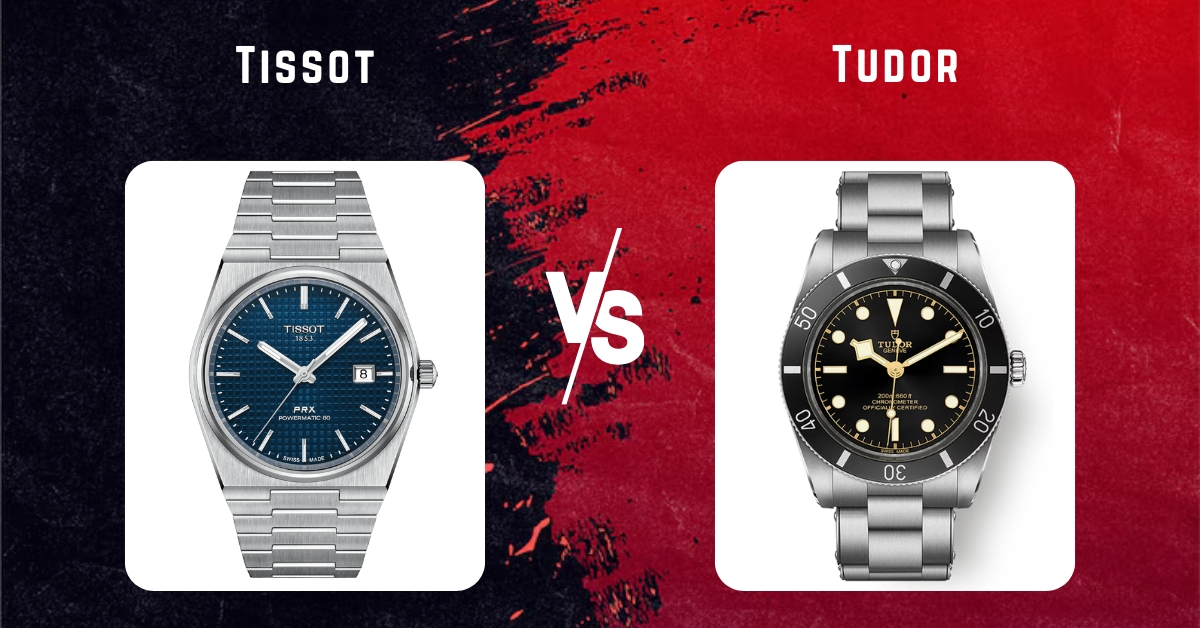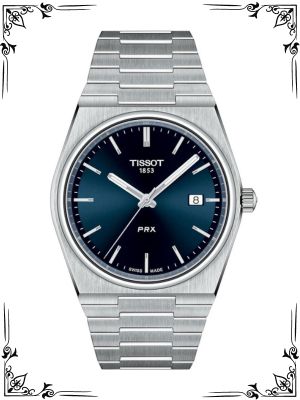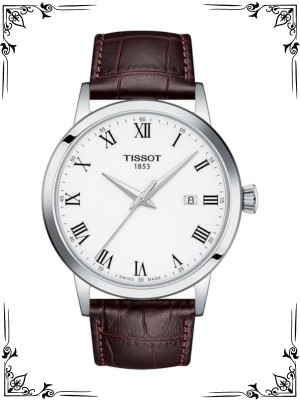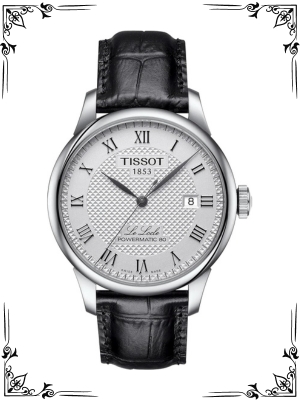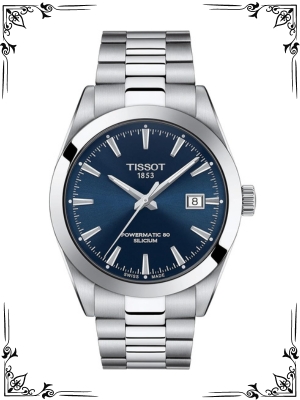The world of Swiss watches boasts a dazzling array of brands, each vying for a coveted position on your wrist. When considering a timepiece that blends quality, heritage, and affordability, two names frequently emerge Tissot and Tudor.
Both reside within the Swatch Group, the world’s largest watchmaking conglomerate, yet cater to distinct segments of the watch enthusiast market.
This comprehensive guide delves into the intricacies of Tissot and Tudor, empowering you to make an informed decision that aligns perfectly with your budget, lifestyle, and watch preferences.
Brand Legacy
Tissot:
Founded in 1853 by Charles-Félicien Tissot and his son Charles-Émile in Le Locle, Switzerland, Tissot boasts a legacy of over 160 years. They established themselves as pioneers in mass-producing high-quality pocket watches, making luxury accessible to a wider audience.
Tissot’s commitment to innovation is evident in its numerous achievements, including the world’s first commercially successful pocket watch with a central second hand in 1894 and the groundbreaking Tissot Antimagnétique, a watch resistant to magnetism in 1930.
Today, Tissot remains a leader in the mid-range luxury watch market, renowned for their reliable timepieces that combine classic design with modern technology.
Tudor:
Established in 1946 by Hans Wilsdorf, founder of Rolex, Tudor was created with a clear mission: to offer Rolex’s quality and heritage at a more accessible price point. Tudor utilized Rolex technology and movements in its early days, establishing itself as a “sister brand” with a focus on sportiness and affordability.
Over the years, Tudor has carved its own distinct identity, developing its own in-house calibers and a reputation for robust, tool watches with a vintage flair.
Table 1: Brand Legacy Comparison
| Brand | Founded | Mission |
|---|---|---|
| Tissot | 1853 | Mass-produced high-quality pocket watches, innovation in affordable luxury. |
| Tudor | 1946 | Offer Rolex quality at a more accessible price point, focus on sportiness. |
Price Point
Price is a significant factor when considering Tissot vs. Tudor. Here’s a general breakdown:
Tissot: Occupies the mid-range luxury watch segment. Their timepieces typically range from $300 to $1,500, making them a more accessible option for those seeking a taste of Swiss luxury.
Tudor: Resides in the upper-mid-range luxury watch market. Their price range starts around $2,500 and can soar well above $7,000 for complex models with advanced features.
Table 2: Price Range Comparison
| Brand | Price Range |
|---|---|
| Tissot | $300 – $1,500 |
| Tudor | $2,500+ |
Choosing Based on Price:
Value-conscious: Tissot offers excellent quality and timeless design at a more affordable price point.
Investment potential: Certain Tudor models, particularly those with a vintage aesthetic and historical significance, can hold their value or even appreciate over time. However, approaching luxury watches solely as investments is not recommended.
Movement
Tissot:
Employs a blend of reliable Swiss quartz movements and automatic mechanical movements depending on the model. Their quartz movements offer exceptional accuracy and require minimal maintenance, making them ideal for everyday wear.
The automatic movements showcase the intricate beauty of mechanical watchmaking but require periodic servicing.
While some Tissot models utilize movements sourced from ETA, a renowned Swiss movement manufacturer, others incorporate their own Powermatic 80 calibers, known for their extended power reserve of approximately 80 hours.
Tudor:
Predominantly utilizes in-house calibers, a testament to their commitment to advanced watchmaking technology. These movements offer exceptional performance and reliability, often boasting features like a longer power reserve and improved shock resistance compared to base ETA movements. Some older Tudor models might still incorporate ETA movements.
Table 3: Movement Comparison
| Brand | Movement |
|---|---|
| Tissot | Swiss quartz & automatic (ETA or Powermatic 80) |
| Tudor | Primarily in-house calibers (some ETA in older models) |
Choosing Based on Movement:
Convenience and accuracy: Tissot’s quartz movements are a perfect choice for those seeking a hassle-free timepiece.
Mechanical marvel: For watch enthusiasts who appreciate the intricate workings of mechanical movement and the advantage of in-house technology, Tudor offers a compelling option. Their calibers often boast additional features like a longer power reserve and improved shock resistance compared to base ETA movements found in some Tissot models.
Materials and Construction
The materials and construction of a watch significantly impact its aesthetics, durability, and value. Here’s a breakdown of Tissot vs. Tudor in this crucial aspect:
Tissot:
- Primarily utilizes high-quality 316L stainless steel for the case material, offering a classic and versatile look.
- Some models might incorporate PVD (Physical Vapor Deposition) coatings for a touch of color or increased scratch resistance.
- Sapphire crystal, renowned for its exceptional scratch resistance, protects the dial.
- Leather straps are a popular choice, offering a timeless and comfortable feel. Some models might include bracelets made from stainless steel or other materials, catering to various preferences.
Tudor:
- Employs high-grade 316L stainless steel for the case material in most models. However, they also offer options in titanium and even precious metals like 18k gold, catering to those seeking a more luxurious aesthetic.
- Ceramic bezels are often incorporated into certain models, particularly diving watches, offering exceptional scratch resistance and a sleek aesthetic.
- Sapphire crystal is standard, ensuring optimal clarity and scratch protection.
- A wider variety of straps and bracelets are available, including alligator leather, rubber, fabric, and sporty NATO straps, allowing for ultimate personalization.
Table 4: Material and Construction Comparison
| Brand | Case Material | Bezel | Crystal | Strap/Bracelet Options |
|---|---|---|---|---|
| Tissot | Primarily Stainless Steel (sometimes PVD coated) | Sapphire Crystal | Sapphire Crystal | Leather, Stainless Steel, Other Materials |
| Tudor | Stainless Steel (also Titanium & 18k Gold options) | Stainless Steel, Ceramic (on specific models) | Sapphire Crystal | Leather, Alligator Leather, Rubber, Fabric, NATO Straps, Stainless Steel Bracelets |
Choosing Based on Materials and Construction:
Durability and affordability: Tissot’s stainless steel construction offers excellent value and robustness for everyday wear.
Luxury and variety: Tudor’s use of precious metals, ceramic bezels, and a wider range of strap options caters to those seeking a more luxurious and personalized timepiece.
Specific needs: For diving watches, Tudor’s ceramic bezels might be a preferred choice due to their enhanced scratch resistance. Tudor’s use of titanium offers a lightweight option for those who prioritize comfort.
Design and Aesthetics
Both Tissot and Tudor boast distinct design philosophies:
Tissot:
- Embraces a classic and timeless aesthetic with clean lines and a focus on functionality.
- Their designs often incorporate vintage influences with a modern twist.
- A wide variety of styles are offered, catering to both men and women, from elegant dress watches to sporty chronographs.
Tudor:
- Known for their robust and sporty tool watches, often inspired by their rich heritage in diving and military timekeeping.
- The Black Bay collection exemplifies this approach, with its vintage-inspired aesthetics and robust construction.
- Tudor also offers dressier models like the Royal line, showcasing a more refined and elegant style.
- Some Tudor models incorporate bold colors and unique design elements, catering to those who appreciate a distinctive look.
Table 5: Design and Aesthetics Comparison
| Brand | Design Philosophy | Style Range |
|---|---|---|
| Tissot | Classic and timeless, often with vintage influences | Dress watches, chronographs, sport watches |
| Tudor | Sporty and robust tool watches, some vintage inspiration | Diving watches, chronographs, dress watches (Royal line) |
Choosing Based on Design:
Classic elegance: Tissot’s timeless designs are perfect for those who appreciate a watch that transcends trends.
Sporty functionality: Tudor excels in robust toolwatches ideal for active lifestyles or those seeking a vintage-inspired aesthetic.
Versatility: Both brands offer a range of styles to cater to various preferences. Consider your lifestyle and desired level of formality when making your choice.
Popular Models
Tissot
Tissot is a well-regarded Swiss watchmaker known for its tradition, innovation, and accessibility in the luxury watch market. Here are 5 of their most popular models:
Tissot Seastar 1000 Powermatic 80: This is a versatile watch that can be dressed up or down. It’s water-resistant up to 1000 meters, making it a great choice for divers. It features a Powermatic 80 movement, which offers a long power reserve of up to 80 hours.
Tissot PRX: This is a sporty and stylish watch that’s inspired by the 1970s. It’s available in a variety of colors and materials, including stainless steel, gold, and rose gold. It features a quartz movement or a Powermatic 80 automatic movement.
Tissot T-Classic Dream: This is a classic and elegant watch that’s perfect for everyday wear. It’s available in a variety of styles, including with Roman numerals or diamond accents. It features a quartz movement or a Swissmatic automatic movement.
Tissot Gentleman: This is a sophisticated and stylish watch that’s perfect for the modern gentleman. It’s available in a variety of colors and materials, including stainless steel, gold, and rose gold. It features a quartz movement or a Powermatic 80 automatic movement.
Tissot T-Touch: This is a feature-rich watch that’s perfect for an active lifestyle. It features a touchscreen display that allows you to access a variety of functions, such as a compass, barometer, and altimeter. It features a quartz movement.
Tudor
Tudor is a sister company to Rolex, known for its quality and performance at a more attainable price point than Rolex. Here are 5 of their most popular models:
Black Bay: This is Tudor’s most iconic watch. It’s a dive watch that’s inspired by the Rolex Submariner. It’s available in a variety of colors and materials, including stainless steel, gold, and two-tone. It features a Swiss-made automatic movement.
Pelagos: This is a professional dive watch that’s water-resistant up to 500 meters. It features a titanium case and a helium escape valve. It features a Swiss-made automatic movement.
Black Bay GMT: This is a GMT watch that allows you to track the time in two different time zones. It’s a great choice for travelers. It features a Swiss-made automatic movement.
Royal: This is a dress watch that’s perfect for formal occasions. It’s available in a variety of colors and materials, including stainless steel and gold. It features a Swiss-made automatic movement.
Ranger: This is a field watch that’s inspired by the military watches of the 1960s. It’s a great choice for everyday wear. It features a Swiss-made automatic movement.
Brand Image and Prestige
Owning a watch is not just about telling time; it’s a statement about your taste and appreciation for quality. Here’s how Tissot and Tudor differ in terms of brand image:
Tissot:
- Represents accessibility to Swiss watchmaking excellence.
- Owning a Tissot signifies an appreciation for quality and timeless design without a hefty price tag.
- A popular choice for young professionals or those entering the world of luxury watches.
Tudor:
- Carries the weight of being a “sister brand” to Rolex, leveraging its prestigious heritage.
- Owning a Tudor signifies an appreciation for robust tool watches with a unique identity and vintage inspiration.
- Offers a more accessible alternative to Rolex, attracting those who seek similar quality at a lower price point.
- Cultivates a passionate following among watch enthusiasts who appreciate its blend of heritage, innovation, and value.
Table 6: Brand Image and Prestige Comparison
| Brand | Brand Image |
|---|---|
| Tissot | Accessible Swiss watchmaking excellence |
| Tudor | Sister brand to Rolex, robust tool watches, vintage inspiration |
Choosing Based on Brand Image:
Value-conscious with a desire for quality: Tissot offers an excellent entry point into the world of Swiss watches.
Aspiring to a prestigious legacy: Tudor’s connection to Rolex and its focus on heritage might hold greater appeal.
Seeking a unique identity: Tudor caters to those who appreciate a watch brand that stands on its own merits, offering robust tool watches with a distinct aesthetic.
User Feedback
Here’s a glimpse into what real-world users appreciate and critique about each brand:
Tissot:
- Praised for:
- Affordable price point: A great way to experience Swiss watchmaking without breaking the bank.
- Classic and versatile designs: Timeless aesthetics that complement various styles.
- Reliable movements: Both quartz and automatic options offer accuracy and minimal maintenance (for quartz) or the satisfaction of a mechanical marvel (for automatic).
- Wide range of styles: From dress watches to sporty chronographs, there’s a Tissot for every taste.
- Criticized for:
- Limited use of high-end materials: Primarily uses stainless steel, with fewer options for precious metals or ceramics compared to Tudor.
- Simpler functionality: Less focus on high-end complications compared to some Tudor models.
Tudor:
- Appreciated for:
- Robust and well-built tool watches: Ideal for active lifestyles or those seeking a reliable timepiece.
- In-house calibers: Many models feature Tudor’s own movements, showcasing their commitment to advanced watchmaking.
- Vintage-inspired designs: The Black Bay collection and other models offer a unique blend of heritage and contemporary aesthetics.
- Wider variety of materials: Options for titanium and precious metals cater to those seeking a more luxurious look.
- Common critiques:
- Higher price point compared to Tissot: A significant investment.
- Can be perceived as lacking the prestige of Rolex: For some, the Rolex association might be a double-edged sword.
- Not all models have in-house movements: Some older models might still utilize ETA movements.
Common Considerations
Before making your final decision, consider these additional factors:
Your lifestyle: A sporty chronograph from Tudor might be ideal for an active individual, while a dress watch from Tissot might suit a formal environment.
Wrist size: The case size of the watch should complement your wrist size for optimal comfort and aesthetics. Try on both Tissot and Tudor models to assess which feels better on your wrist.
Personal style: Do you prefer a classic and understated look or a bolder and more robust tool watch? Choose a watch that aligns with your overall style and personality.
Investment potential: While not the primary reason to buy a watch, some Tudor models, particularly those with a vintage aesthetic and historical significance, can hold their value or even appreciate over time.
Choosing Your Champion
Ultimately, the decision between Tissot and Tudor boils down to your priorities and budget. Here’s a quick recap to guide your choice:
The Value-Conscious Choice: Tissot
- Offers exceptional quality and timeless design at a more accessible price point.
- Reliable quartz or automatic movements ensure accuracy and minimal maintenance (for quartz).
- Classic and versatile designs complement various styles.
The Robust Tool Watch Enthusiast: Tudor
- Robust and well-built toolwatches are ideal for active lifestyles.
- In-house calibers showcase their commitment to advanced watchmaking.
- Vintage-inspired designs offer a unique blend of heritage and contemporary aesthetics.
- A wide variety of materials cater to those seeking a more luxurious look.
Remember: There’s no single “correct” answer. The best choice is the watch that resonates most with you, complements your lifestyle, and brings you joy every time you wear it.
FAQs
Is a Tissot a good watch?
Absolutely! Tissot offers exceptional quality, reliable movements, and timeless designs at an attractive price point. They are a great entry point into the world of Swiss watches and a solid choice for those seeking a reliable and stylish timepiece.
Which brand offers a better warranty?
Both Tissot and Tudor offer a standard 2-year international warranty on their watches. This warranty typically covers manufacturing defects but not wear and tear or damage caused by misuse. It’s always best to consult the specific warranty information for the model you’re considering.
Should I buy a pre-owned Tudor or a new Tissot?
This depends on your priorities. A pre-owned Tudor can be a great way to acquire a higher-end watch at a more affordable price. However, be sure to purchase from a reputable seller and have the watch authenticated and inspected for any potential issues. A new Tissot offers the peace of mind of a full warranty and the joy of owning a brand-new timepiece.
Where can I buy a Tissot or Tudor watch?
Authorized retailers are the safest option for purchasing a genuine Tissot or Tudor watch. These retailers will have a wide selection of models and can provide expert advice to help you choose the right watch for your needs. You can also find pre-owned models from reputable online sellers or watch forums, but conducting thorough research is crucial to ensure authenticity and condition.
How do I take care of my Tissot or Tudor watch?
Regularly clean your watch with a soft cloth and avoid harsh chemicals. Depending on the model, you might need to replace the battery (quartz) or have the movement serviced (automatic) periodically. Always consult the manufacturer’s instructions for proper care. Additionally, avoid exposing your watch to extreme temperatures, strong magnetic fields, and excessive shocks.

